When the Beings in the Room Come Alive
A roundtable on virtual dance, pandemic making, and being a human in the field with Arneshia Williams, Megan Mayer, Tumelo Khupe, and Emily Michaels King
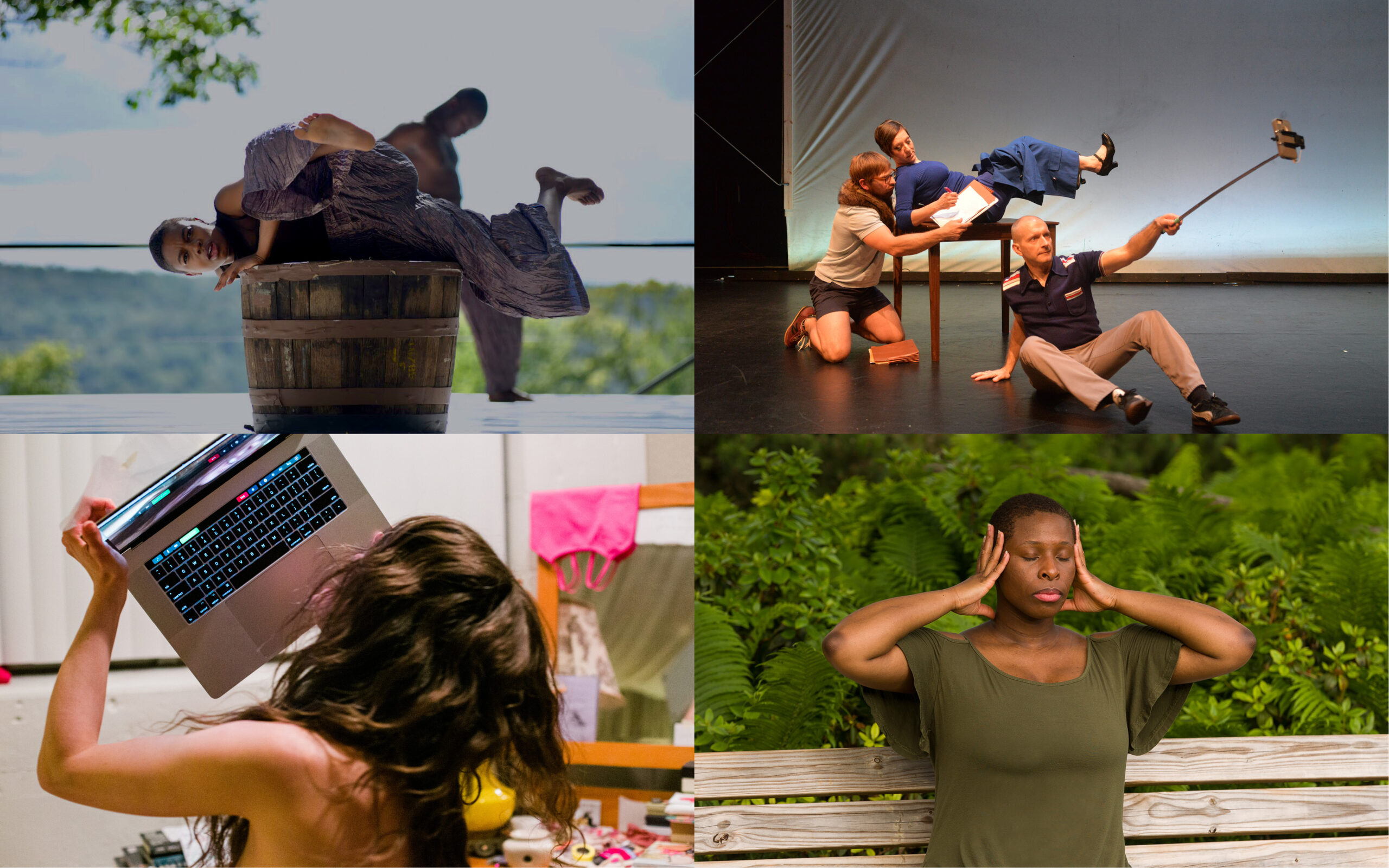
It’s an unprecedented time for dance. What shifts in practice are dance artists making? How will dance as a field survive and thrive? What new spaces are coming alive?
We invited artists Arneshia Williams, Megan Mayer, Tumelo Khupe, and Emily Michaels King to explore these questions on virtual dance, pandemic making, and being human in the field. As Choreographers’ Evening returns to the Walker stage, this roundtable is one way of expanding the critical exchange on dance now with dance artists.
Kayva YangHow has your artistic practice been shape shifting during this time of immense change? Are there approaches you have been percolating on, experimenting with, or even letting go of?
Arneshia WilliamsWhat I’m noticing is me letting go of a sense of control. Whatever control I think I have, or however I might be planning, endeavoring, hoping, wanting things to come together—those lines have become increasingly fluid.
It’s because of the pandemic, but also because of how people are dealing with life—being human and being artists at the same time. What a fellow artist needs as a human being, as a collaborator, has completely shifted to the top for me and my practices. I’m excited about this because I believe the work is finding a deeper place in me and the people I get the privilege of collaborating with.
What this means when we work with each other, and for the human beings we get to share our work with, is transcending a lot of barriers, assumptions, and guarding of self. I’m like, “Oh snap, where is this going to go? I have no idea, but let’s go.”
Megan MayerArneshia, did you collaborate with people before the pandemic or has this come out of the pandemic? I’m super curious.
AWI collaborated with people before the pandemic. Collaboration with others has always been something I wanted, needed, and desired as an artist. There’s been an uptick in that desire right now. I feel like if I’m not collaborating with someone, it’s not happening.
But I’ve also been feeling like people are tired right now, tired of whatever it is. As a result, people have felt more open to what is possible. People are showing up as real human beings, who care for real, and are open to discussing whatever ways we need to shift with and for each other.
That is the depth I’ve been appreciating because it’s some of what we need, even if we don’t know we need it right then. Sometimes we can’t name the thing, but we know we need a thing.
Tumelo KhupeFor me it’s interesting because I graduated a couple months before the pandemic lockdown. I wasn’t sure of where I was going with my art, but was learning and soaking in all this information. This period gave me time to figure out what I want to do with this information instead of jumping into the field.
I asked myself, how put together do I need to be? This is something I’m trying to let go of. Also, how do I fit into my own story? I’ve realized I’ve been seeing my story as a third person. I tend to say, “This is a work that I’ve created and this is me,” but that’s not true. It’s just a part of me in the journey that I need to put out there. So then, how do I embrace my complexity? These are steps I’m taking to get to wherever I’m going. Let’s allow what happens to happen, while noting the different things along the way that I want to hold onto, and what I want to let go of—and why.
Emily Michaels KingSomething that feels a bit kindred with what’s already been shared is the artist’s voice and the work. A deep focus of my artistic approach is investigating what it means to be a human, what it means to have a body, to have trauma, to have memories. This pandemic time and diving into the virtual space made examining that interior world more possible than it was before.
When the pandemic hit, many artists beautifully and quickly pivoted to the online space. I really held back at first because I didn’t feel like my archival videos would translate well to video format. Also, I’m not a filmmaker. So for a couple of months, I did visual art and got my artistic output in other ways. Then in August of 2020, I did an online dance workshop via Zoom and started working in this format.
Being a graphic designer, art director, and photographer has always peripherally supported my work, primarily in marketing. When I started to work on my computer, there was a great conjunction of different aspects of my life into the performance space. I could suddenly use my other skill set directly in performance making. It was mind-blowing. It opened up my world entirely. I wasn’t making work that defaulted to being virtual because of the pandemic, I was making work that had to be virtual by nature. This was a really powerful shift for me.
TKEmily, in making this shift to the virtual, do you feel like anything is lost? Has this had a major impact on your practice or was something found in the virtual space?
EMKThat’s such a great inquiry. I was conscious of trying not to replicate work that can only happen in person. From that initial workshop, the seed was planted that I can work in a different way in virtual space. I ended up creating an evening-length work called Digital. I decided to perform it live each night via Zoom instead of releasing a video of it. It was important to me that wherever the audience was, they knew I was actually in my bedroom at that moment, moving around, and that a kind of energy was conjured by that.
There’s also the tension of—how we are not in the space together?—on the one hand, and that the audience is gaining access to my intimate home space, which would not occur in a theater, on the other hand. These tradeoffs create not only tensions, but invitations, which are interesting to poke at.
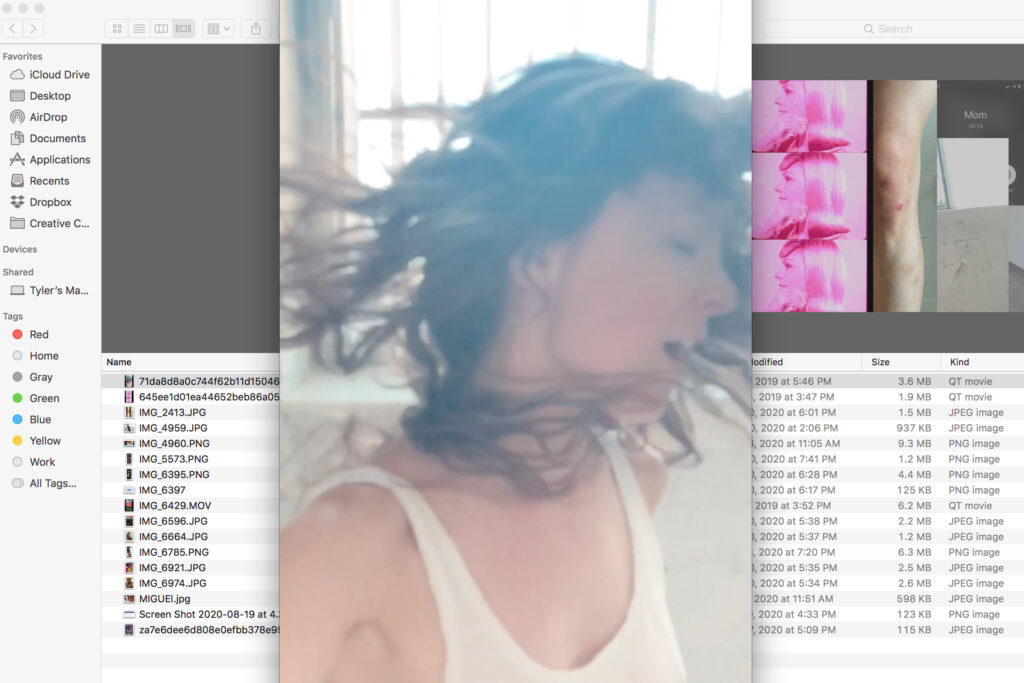
Emily Michaels King, DIGITAL, 2021. 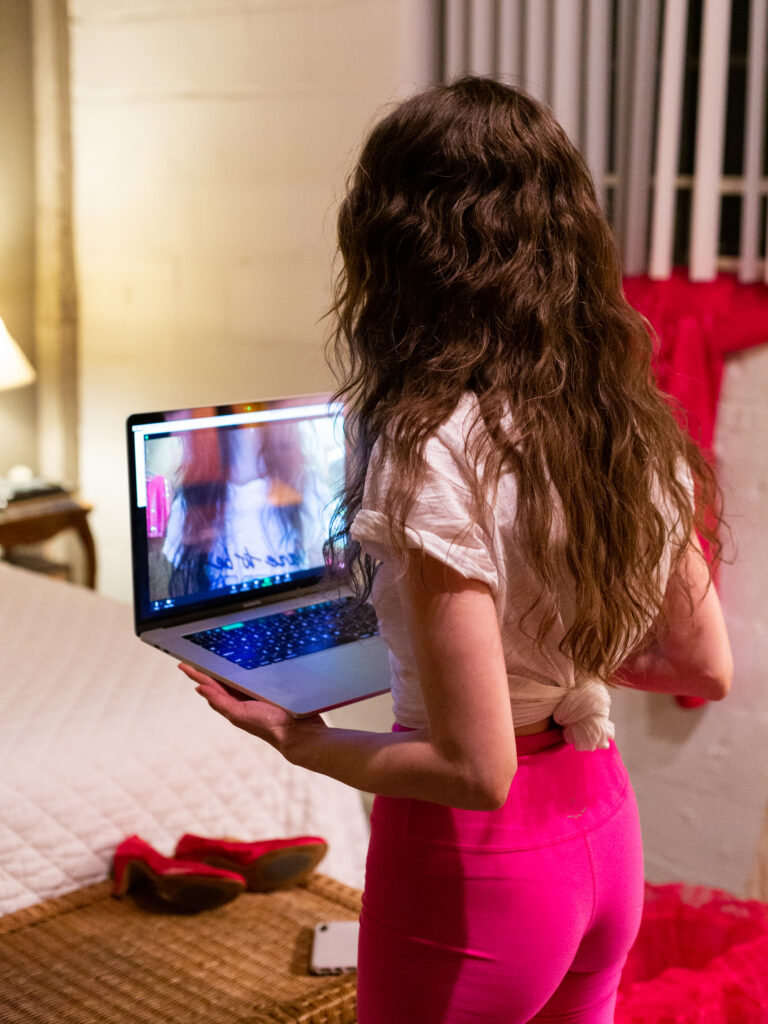
Emily Michaels King, DIGITAL, 2021. 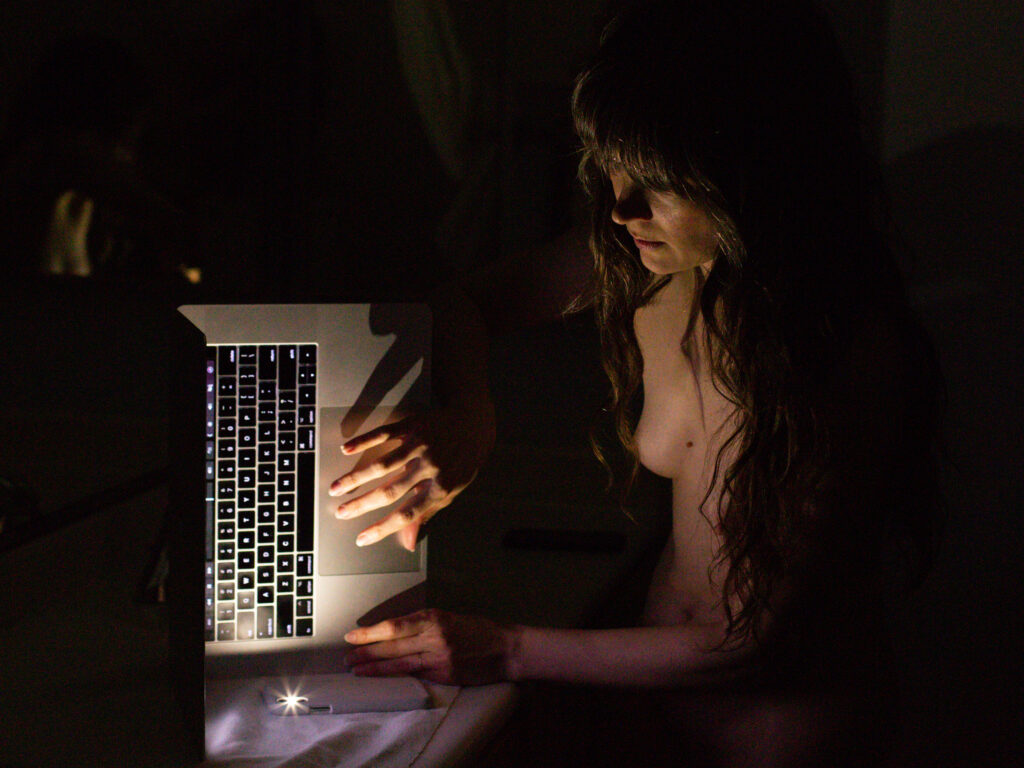
Emily Michaels King, DIGITAL, 2021. 
Emily Michaels King, DIGITAL, 2021.
MMI’m glad you [Tumelo] asked the question about shifting to virtual space because it brings up where I’ve been in this pandemic time. I have not been making art.
I work in human resources where I’ve been in charge of COVID medical leaves. This has been exhausting. Like Arneshia said, people are tired and I am tired. I also have a lot of frustration with how dance as an art form, because it couldn’t exist live safely, was hit so quickly and so hard and so brutally. That made me so sad that it was hard to wrap my head around making anything. The inequitable nature of dance and arts funding also made me feel resistant to applying for grants to make future work. How is this going to work? Do we as artists want to take part in this again? That said, awesome conversations are happening right now to change this inequity.
Having made work for 30 years, half of which has been in video and photography, it was interesting to watch the pivot to: dance is a video. Many choreographers and dancers made this shift quickly in response to the new reality. I see this resilient ability of dance artists to adapt in order to still have an artistic outlet in a wild time when few had resources and nobody had dance space.
I didn’t have much appetite or attention span to watch videos of dances. So, Emily, when you made a live performance for people to come to and share a space with, instead of recording dance on video, that was really appealing to me and something I missed.
INTO A SOW (how you say) was a video I made a year ago. Since then my go-to has been my phone. I have these weird movement things I take on my phone, and I don’t know what I’m making. Sometimes I edit them together, sometimes I post them, sometimes I don’t do anything with them. As they accumulate, I realize I’m making little anxiety videos. Most are body-based, but not usually my body. Social distancing has instilled a fear of other people’s bodies, which I’m trying hard to fight against because everybody has some hang-ups about the body. I think as dance artists we live in a world where you have to be comfortable with this duality.
TkI’m really reflecting on this period of not working you spoke about, Megan. Especially rest, and how important it was to shut everything off, to rest long enough to hear what was going on. This period of rest or not working has turned my senses on stronger than before pandemic times, because before it was going and going and going and going, taking in whatever. Now I have a fresh perspective on going with the flow: do I want to go with the flow, or do I want to go against it?
EMkI deeply resonate with how you’re utilizing technology, Megan. Despite the potential to use highly advanced technologies to make work, I have found and am now full-on embracing the low quality, low-res pixelation, and not apologizing for the ordinariness of it and the messiness of it. An unexpected discovery is that my evening-length show via Zoom is the cheapest show I’ve ever made. From a producing standpoint, it was more economically feasible, in part because it was low-res.
We’ve been so “in” our humanness, confronted by everything in the world, I even felt this way with my devices. The computer and phone are devices that have the connotation of being soul-sucking; however, as the entities I’ve been in the room with, they came alive for me in a new way. They have become my collaborators beyond being tools. I’ve found they have their own movements, capabilities, and qualities. As an artist who is naturally drawn to looking at the interior space, working with the devices has been a reflection of our human complexity. They have this unique power to help reveal us: the physical, the digital, and the psychological space.
kyEach of you viewed one another’s performances as, or on, video. What spoke to you and how did it resonate with your own practice?
MMI was intrigued that chairs were featured in all of the videos. Skin and truncated body parts also seemed very important. Each video had an aspect where a limb was shown without a face, or a part of a face and not the rest of the body. When you’re live in front of an audience, you don’t have that option.
AW I noticed some of those same things. I was paying attention to movement and body limbs. Hands seemed very important as well. How it was being shown—sideways or diagonal. Is the dancer upside down or on the floor, or is the camera or camera phone above you? Those things definitely drew me deeper into your works.
EMK There’s been such an imposed confinement and stillness about the last 18 months. That felt really present in all of the work, whether it’s moving into an outdoor space and feeling the expanse of the animal body taking up space, or that feeling of confinement and pressing into it. There’s extensive movement in all of these works, but there’s also a kind of restriction. I really align with this curated perspective: what is seen and what’s not seen is charged somehow. I love being able to really put the focus on something, zoom in and allow attention to be here, and then specifically not here.
kyWhat change have you experienced from within the dance communities you sit in? And what impact have you seen this moment have on dance as a field?
TKI am a Krumper, and the Krump scene, we say it just never dies. It’s like a never-ending conversation that has been happening within the Krump community, specifically in Minnesota. Because of the pandemic shutdown, it’s almost like this is all we have. Especially during the time of George Floyd, this is all we had.
The way Krump is experienced, it’s a language within itself. The hand gestures mean something specific. Because there’s a group of artists who understand that language, there was a closeness I haven’t felt before. It’s a place of healing. You all come together to say what you got to say. Now I understand, in these tough moments, this is where I need to go to be heard and to connect with people who actually understand what I’m saying. I don’t have the words to say what I feel, but here’s a language I can tap into that brings it more alive. As you were saying, talking about the aliveness.
Hopefully through the use of the virtual world, there can be a closeness, universally. Because now, just as an example, I can watch a video of a dancer in Indonesia and they’re communicating something. As a dancer, I think, wow, I connect with that person who’s on the other side of the world. Now I have a deeper understanding of how adaptable dancers are. Going even deeper, I’m seeing the parallels between dance and my real life.
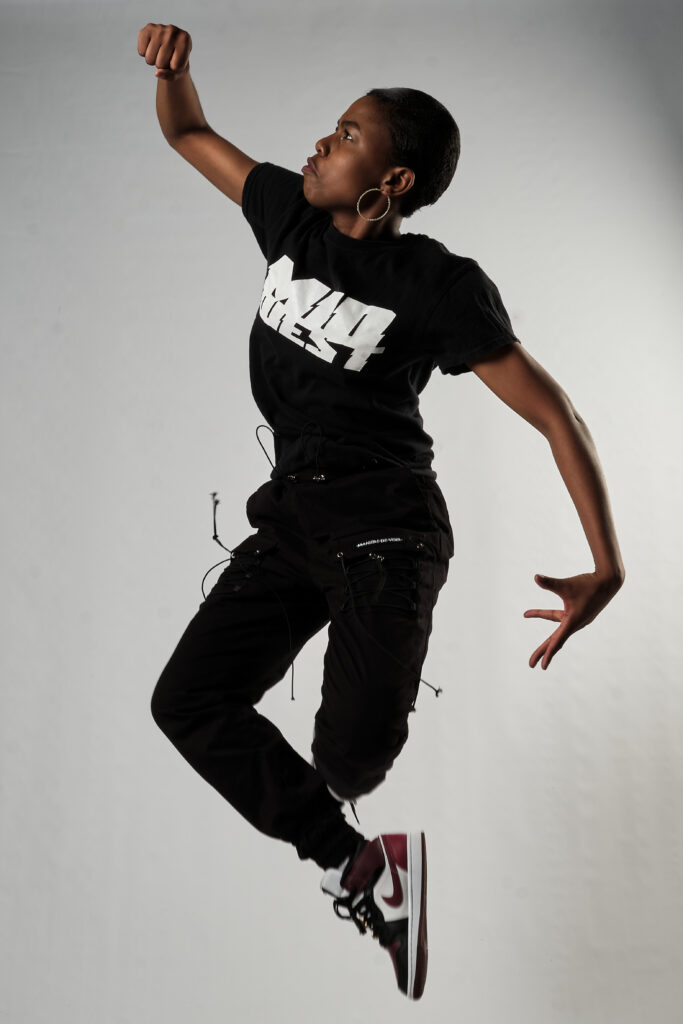
AWI’ve been resonating with what Tumelo said. I sit within dance communities that tap into the lineages and contemporary makings of African diasporic practices. That might come via West African dance, as well as house dance, or hip-hop, or even contemporary dance. Being at the intersection with and within these communities and persons, I’ve been seeing a different kind of transparency with practices and with experiences, like skill-sharing. This artist got this commission or this opportunity and then they share their experience—I’m also seeing this happen more broadly.
I’m also seeing people in these communities being willing to share both the frustrations and the great things—like when something wasn’t seen in your work, or you don’t feel appreciated as a dance artist, I want to hear. We want to hear when good things are happening to you, because we want to celebrate you. I feel like that’s been growing in the practice, as well as the broadening of making in this time.
We know that we’re innovating, because the connection and the skill-sharing is happening in a different moment, and we’re vocalizing it now because we know we are not always going to be in the same space. Maybe I had to go get my COVID test yesterday and I don’t know if I have COVID right now, so I can’t come to that rehearsal. Or maybe an artist’s parent is sick and they need to go take care of them, or I need to go to the daycare. We are more aware of this care.
Some of it is about surviving. What does it mean for this field that we love? What does it mean for it to survive and to grow but also transform? Because there are some things that aren’t actually working. Not for real. We’ve learned how to deal with it, but maybe we don’t really want to deal with it—and we actually shouldn’t have to deal with it, because it’s not a practice that helps us be better human beings, who are artists. Maybe we want to rethink those ineffective practices.
KYArneshia, what is a practice in the dance field you would like to see transform?
AWSustaining artistic practice and funding, and what that means. I’m seeing this conversation become more transparent. Sometimes you don’t know who can or can’t apply, or who knows someone on the board who got some information. Sometimes funders need to make sure they allow a grant opportunity to be open for “everyone”—but everyone is not truly given a chance because there is already an artist they have in mind to select. I’m not saying this funding structure is not going to continue—I’m saying that during this time, I’ve heard more people say this uneven dynamic is happening. Organizations are saying they need to make their practices more transparent so that artists have more of an understanding of how funds work.
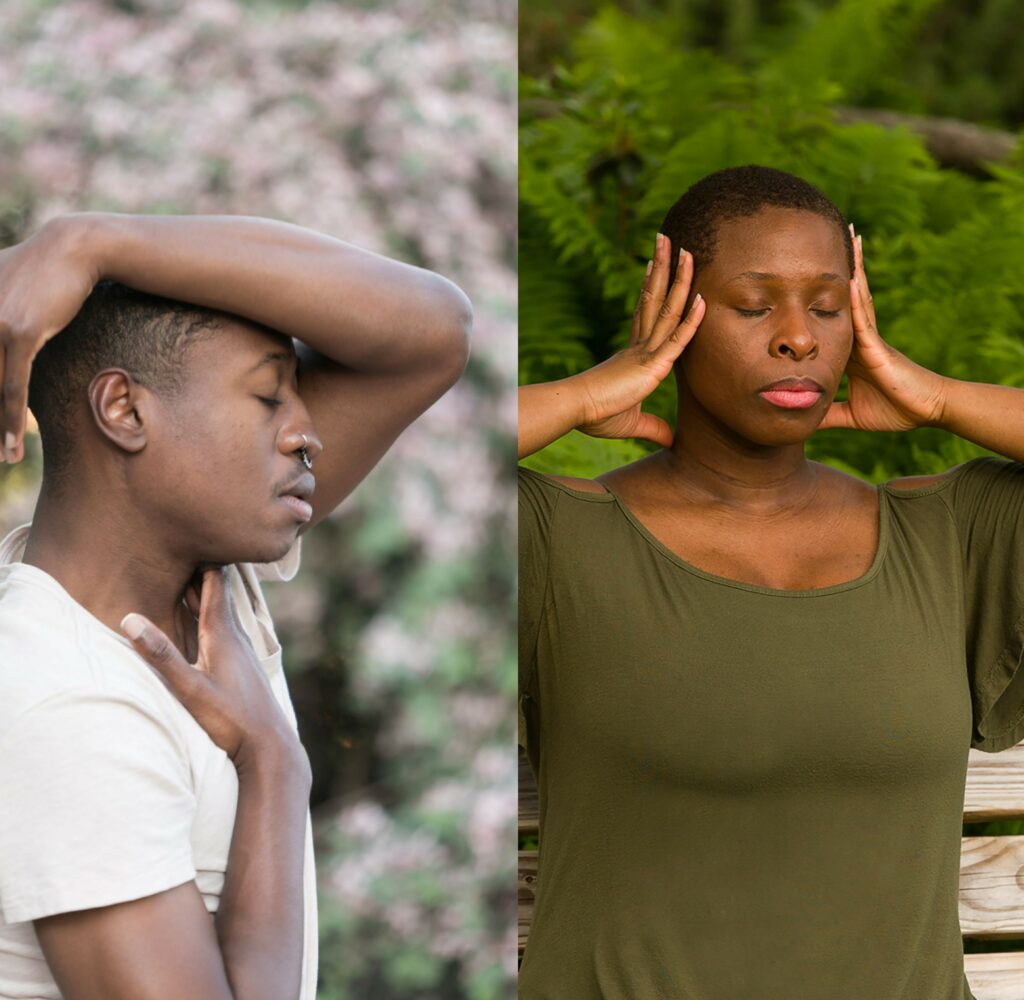
MMFrom my microcosmic view, I know I’m part of a dance community, but I also feel very separated from that, as I think many people do. So, it’s highly encouraging to hear everyone here talking about feeling connected to their community. I have not had that experience as much partly because my full-time day job has pulled me away.
A lot of people in my community were organizing around funding, examining these power structures, and trying to look at why it’s problematic, dismantle, and reform it. This was especially true of dance artists who were self-employed and whose primary work was gig-based. They organized, which is classic. Dance artists never stop working; we’re always trying to make things better.
Right now, I’ve had a foot in both and neither of those places of organizing and making. I have an evening-length piece that I’ve been working on for a few years now that was interrupted by the pandemic. I was in the middle of a residency when the pandemic lockdown occurred and it became unsafe to continue working for the health of my collaborators.
I really miss going to shows. Even though I miss conversations, pre-show and post-show, I also kind of dread it because I dread the question, “What are you working on?” While nobody’s expecting a brilliant answer, my headspace is filled up with this piece that’s on hold. Although I can start something new, it’s sometimes hard to work on more than one thing at a time. I’m kind of a serial monogamist when it comes to making work. So that’s something that I’m dealing with, and it’s been gratifying to listen to everyone today to hear how you’re coping with that.
EMkI’m with you, Megan—having belongingness and being outside at the same time. I’m a very introverted person, so I’m kind of solitary by nature. Everyone has touched on this a little bit, but I sense that there’s so much more space and permission for us to be whole people than there ever was before. I don’t know, it almost just feels like a relationship maturing where everyone is seen as a full adult person with needs and boundaries. It feels like there’s just more possibility around that now than there was before, because everyone has just been in the shit.
What I see coming forward is this greater willingness. Not only in these spaces to just be humans together, but in the work too, there’s a little bit more vulnerability and intimacy. Everyone is coping with so much wounding and trauma and questioning. I see that being processed and expressed in the work, and I love that. I’m really drawn to that because it makes me feel less alone.
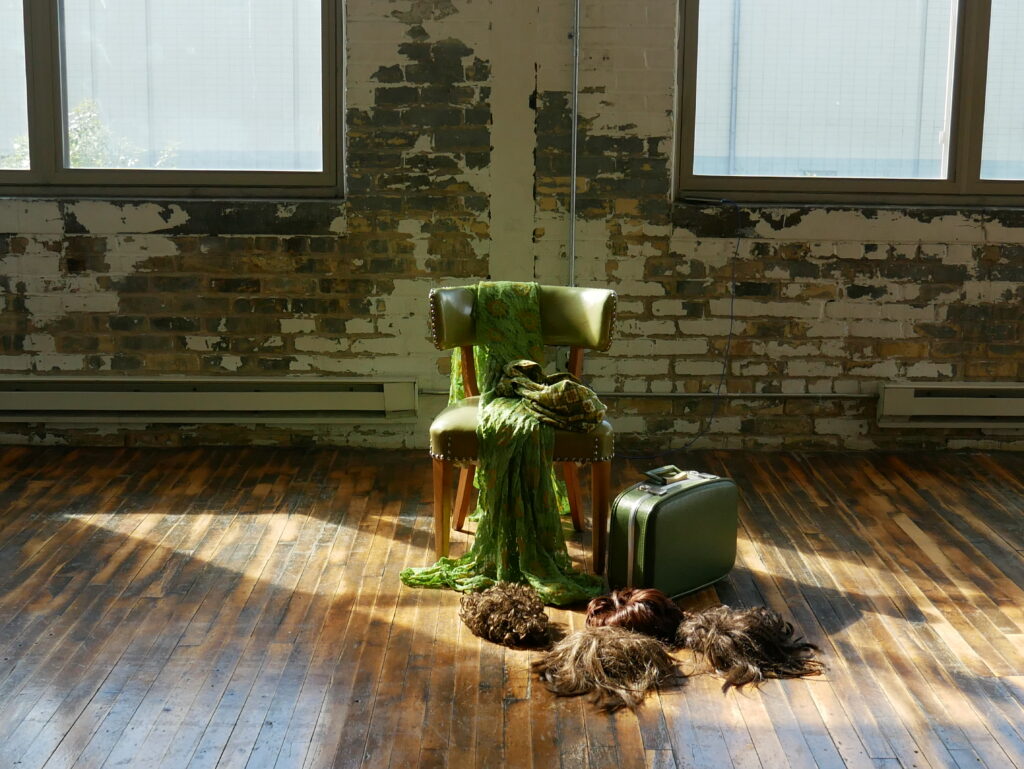
kYLooking ahead, what do you anticipate this time of change will bring for you as an artist and for the dance world?
TKI’m asking a lot of “why” whenever I work. Why, why, why? To get the best out of my work, I have to begin by either writing or recording improv without any direction and then look back at it and ask, “Why did I do that move or gesture? Why did I stop and breathe at that specific point?” Or if I’m writing and reading, “Why did I choose to use this word?” Why did I choose these things? Then whatever comes out of this study depends on whether I want to share it or not. Do I want to be generous with this information, or do I want to keep it to myself? Keep it in my phone, for example, like Megan was talking about, or do I want to share it?
Also, I’m really stuck on what Arneshia’s been talking about, collaboration, and these types of conversations that I rarely see published. These are important, because although some of us have felt some type of breakthrough during this period, a lot of artists have dropped out and a lot of them have felt as if this is not going to work, because again, livelihood and just trying to survive. Maybe they feel lost, not able to connect with each other. So many different reasons.
So collaboration is something that I’m anticipating, bringing in ideas, trying to figure out how we as a collective can work together to keep this thing growing and developing. Because I’ve been so concerned about how to fit into my own story. It’s not something that you can figure out in a week, but having other people there helps you figure that out. So collaboration and conversation.
AWI’m going to ditto what Tumelo said. I anticipate collaboration, I anticipate places of thankfulness and humility as I collaborate with, and get the privilege of learning from, people and artists and communities that invest in each other and thrive. And I anticipate a lot of good messiness, a lot of not knowing, and figuring out what to sow and how to sow and what to retract—like, “Oh, snap, let me try something different here.” And I’m hoping just for the peace and the grace as I go through it, and the different communities I’m connected to go through it.
I would say almost a non-defining has come up. Instead of being like, “Oh, I do this,” or, “I do this”—maybe it’s, “This and this is true,” or maybe, “This, and this, and this, and this is true.” I think I’ve allowed myself to widen how I work, from where I have to and/or need to from a technical and logistical standpoint, to where I’m looking and feeling things in a different way.
MMAs an older artist who’s been doing this for a long time, I think that before the pandemic, there was an issue already of sustainability. The phrase “mid-career artist” just implies that if you’re a new artist and then mid-career, what do you do in the last third? Nobody even speaks that word or talks about that. There was already a problem with erasure of aging, and in dance specifically when it’s body-based. And sure, your body doesn’t work the same it did when you were 20. But I anticipate artists having zero fucks left to give, not being apologetic for who they are, and as it’s been said, being human, and fully human.
I think it’s so important to continue to keep holding funding agencies accountable and calling it out when it isn’t equitable. And we’re lucky that the dance community is a small art form in the realm of the rest of the world. We can march right into somebody’s office and have a conversation with—I’m not going to name any. Well, I’m going to name the Minnesota State Arts Board. You can call up the head of the State Arts Board and tell them what you think about what they did during the pandemic.
I think we already do that as artists, but I anticipate more standing up for each other. And if you know something’s going on that isn’t equitable or isn’t cool, there is just no time left in our lives to be quiet about it. So I’m excited about that and feel charged up about that.
EMKI think what I’m sensing is a bit more in the abstract, floating, energetic space, but I am anticipating in our communities and in the places where our communities overlap, just there being room for us to really see and appreciate one another. It’s such a gift to be in this conversation right now, and to have everyone be able to sit in their own expertise and to receive the gift of that. So I anticipate spaces where we can all come together and be in our own power and also share and exchange that with one another. It’s so beautiful.
KYIt gives me hope to hear each of you talk about your practices, discoveries, and visions—the good, messy, unknown, being and becoming—in dance now and ahead. I too anticipate more spaces to come together. Thank you for generously sharing your voice and contributing to this space today.
Choreographers’ Evening 2021: Curated by Valerie Oliveiro takes place Saturday, November 27, 2021 at the Walker Art Center. More information at walkerart.org.
This conversation has been edited for brevity and clarity.
About the participants:
Emily Michaels King is a performing artist based in St. Paul, Minnesota, exploring sensory and embodied engagement in live experiences through movement, multimedia, and visual art. Her work has been presented at the Walker Art Center, the Guthrie Theater, and the Southern Theater, among others. Emily is known for her collaged solo performances, including her award winning show MAGIC GIRL and the recently premiered DIGITAL, which she performed live from her bedroom. Pairing minimalism and subtlety with cacophony and bared irreverence, Emily’s works employ the lush landscape of the inner world and the power of unapologetic vulnerability. They combine movement with text, graphics, sound, and sculpture to focus on themes of self discovery and reclamation, womanhood, and bold, or supremely delicate, expressions of personal truth. www.emilymichaelsking.com
Tumelo Khupe is a Krumper, emerging choreographer, and actress based in the Twin Cities area. She began focusing on her passion for performing arts while still living in Botswana. In 2016, she moved back to the United States to pursue a career in performing arts. Tumelo is at the early stages of her evolution as an independent artist. Still, through connecting and working with Maia Maiden, Darrius Brown, and more recently, Herb Johnson III, she has become a part of the street dance community, more specifically the Minnesota Krump (MN KRUMP) community—aliases “Lady Stain” and “Twin QP.” As she continuously works to learn and understand the beauty in the culture of Krump, she takes an interest in how Krump captures spoken and unspoken stories. Krump offers endless possibilities for storytelling through its technique and language shared amongst its practitioners and provides a shared experience that encourages community building. She also takes an interest in how the body naturally captures critical moments in life that can reveal themselves through improvisation and uses some of these principles in her work. She works closely with Wynn Fricke, Cláudia Tatinge Nascimento, and Patricia Brown, who also mentor her. She graduated with a B.A. in Music Theater with a minor in Dance, May of 2020. Some awards received in college are the David Wick Leadership Award, David Wick Best Choreography Award, and The Mabel Meta Frey Outstanding Theater Artist Award. She has also competed in Krump tournaments out of state, coming first place at the first “King of the Ring” event in Texas in 2020.
Megan Mayer: “As an artist I’ve worked with choreography, dance, experimental video and photography in Minneapolis since 1991. I obsess over transposition, translation, minimalism, mimicry, tenderness, wry humor, loneliness, social anxiety, fake bad timing and exacting musicality. I make deeply personal dances that celebrate the people performing them. My work has been supported by McKnight Foundation Choreographic Fellowships, project grants from MRAC, MSAB and the Jerome Foundation, and by residencies at the National Center for Choreography (NCC) in Akron, Ohio, the Maggie Allesee National Center for Choreography (MANCC) in Tallahassee, Florida, the Center for Performing Arts in Minneapolis, and now, at Red Eye Theater.” www.meganmayer.com
Born in Stillwater, Oklahoma, Arneshia Williams is a weaver and mover who creates with an underlying purpose of sharing experiences that help uplift and reframe the culture of today. She views her artwork as snapshots into the social, cultural, and spiritual dimensions of life. Often referencing history as a distanced conceptual backdrop, her work explores contemporary relationships through performance. She is interested in dance, vocality, sound, and media and is particularly invested in African Diasporic and Black American forms of expression. Arneshia has been awarded residencies and scholarships to support her choreography and danced works by communal and nationally known artists. Recent residencies and support include Dea Studios, Momentum: New Dance Works, 331 Studios—Rosy Simas Danse, and MRAC Next Step Fund. Her written publication record include topics within the areas of dance, the African diaspora, and spirituality, with a focus on bodied spiritual expression, dance education, and community.